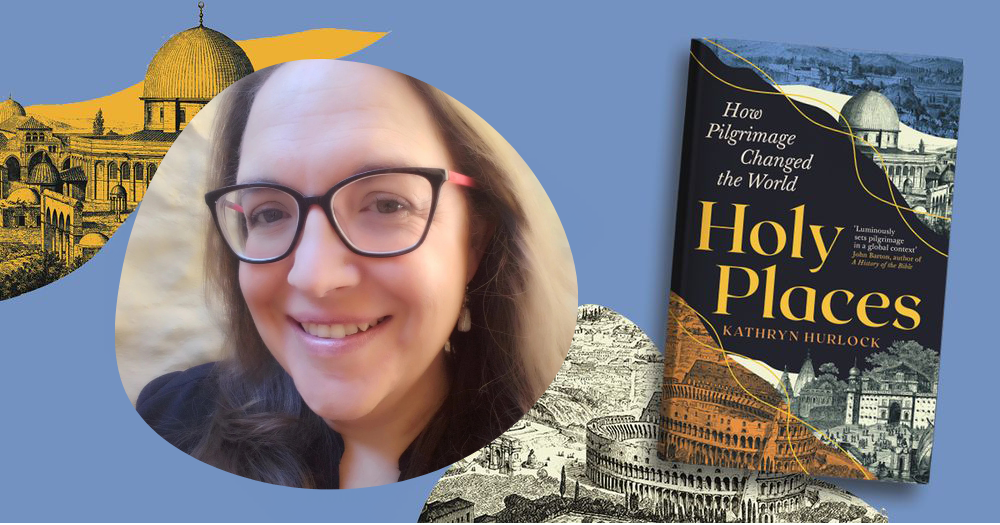Review: Holy Places: How Pilgrimage Changed the World, Kathryn Hurlock, Profile Books
The writer Samuel Johnson thought it showed a deficiency if people weren’t inspired by particular historical and religious sites, and it seems that there is a natural impulse in human beings to revere certain places and want to visit them, hoping to be inspired or rejuvenated spiritually.
For Christians, Jerusalem was (and is) an obvious pilgrimage destination. Jerusalem was the centre of the world, according to medieval maps, a geographical depiction that correlated with the way Christians thought of Jerusalem as the centre of the world historically. For Muslims as well, the city is holy – the jumping-off point for Muhammad’s visit to heaven and the site of future apocalyptic significance. For Jews, it is the site of the temple, (re)built by Herod for the purpose of pilgrimage, which, in his eyes, equalled commerce. The New Testament tells the (plausible) story of Jesus’ family on pilgrimage in such a large group that they didn’t notice the young Jesus missing until days after.
Later Christian pilgrimage would elevate the ordinary, even unseemly, place: the Church of the Holy Sepulchre was built over the place where Jesus was executed as a common criminal; in Bethlehem, a gold star marks where, according to the Gospels, making a theological point, Jesus was born into such lowly status that Mary had to give birth like one of the farm animals. The author of the earliest surviving pilgrimage account describes visiting the half-finished Church of the Holy Sepulchre in 333AD, not long after Constantine started the process of turning the Holy Land into a theme park (while Jews were suddenly banned from their sites of pilgrimage). The process compounded: monasteries and convents were built, miracles occurred there, drawing even more pilgrims.
Muslims destroyed the Church of the Holy Sepulchre in 1009, and Christians claimed Christ’s tomb was destroyed, but then the church was rebuilt, only for Christian pilgrimages to be stopped – one of the reasons for the Crusades. The tenuous nature of rule of Jerusalem meant that Rome became a substitute in the early Middle Ages. Relics by the wagon-load poured into Rome, reportedly, with a focus on martyrs, Saint Peter being the most prominent. The city was redesigned around pilgrimage routes.
One could shop for relics and take them elsewhere to create a pop-up pilgrimage site, something Constantine had done years earlier in Constantinople. He and subsequent rulers went on such a treasure hunt that it seems all that was missing was, in the words of relic-sceptic Martin Luther, a ‘large, heavy piece of the shout’ that knocked down Jericho. Many of Constantinople’s relics were looted in the Crusades, though some remained, including valuable icons which Western Christians weren’t interested in. The pilgrimage enthusiasm didn’t stop with Muslim takeover, though – sacred waters were a draw, as were relics of Muhammad.
Pilgrimage could be used politically – in Jerusalem, pilgrimage was an excuse for a Western presence when in was under Ottoman rule. Supporting pilgrims was good PR, for rulers and pilgrimage destinations, and rulers wanting to get on the good side of the Church made their own pilgrimages. Some did it in luxury, some took it seriously and trod barefoot and in their underwear.
Over the course of history, pilgrimages have been good for local businesses, and the gullible a boon for merchants of relics, manufacturers of glow-in-the-dark rosaries and publicans. One can’t, however, argue with pilgrims who have turned their lives around or simply found renewal through pilgrimage. The Camino in Spain ends at a shrine with (supposedly) the remains of Saint James, but pilgrims are not exclusively Catholic, using the pilgrimage for a rite of passage, reflection and, not unrelated to the modern fashion for long hikes, time in the outdoors. We are physical beings, and sometimes we need a change of environment to ferment a change in attitude.
Of course, pilgrimage is not merely a Christian phenomenon. And Kathryn Hurlock reminds us that fashions wax and wane with religions. Delphi, in Greece, was a significant pilgrimage site, a place for prophecy and answers to questions such as which god to worship to ensure success in whatever one’s pursuit – often war. (If you didn’t like the answer, you could head off north to the oracle of Zeus for a second opinion.) But Delphi eventually fell to ruin, only rediscovered in the nineteenth century during the archaeological craze.
On the Ganges, tens of millions set up a temporary city every 12 years or so, to celebrate immortality at the place of contact with the gods. The downside to this is disease outbreak, from millions of people gathering, and a very polluted river. Efforts to clean up the river may restrict access, and this would cause unrest, so the Ganges and its relationship to religion remains a political problem. For more-or-less mandatory Islamic pilgrimage, the dangers have been caravan robbery, religious violence and overcrowding to the point of being crushed to death. (And deaths on the hajj continue). This is not moderated by those who think that dying on pilgrimage is a positive.
More recent religious pilgrimage sites include Ratana Pa in New Zealand/Aotearoa, where a Maori healer converted to Christianity in the early twentieth century and saw visions calling him to evangelise to and heal fellow Maori. Ratana was very popular, receiving requests for healing from all over the world. He mixed Anglican and Maori beliefs such that eventually the Anglican Church declared him schismatic – it is common for new cult sites to come under the suspicion of religious authorities. Now, the site is as much a destination tied to political expediency, with New Zealand’s political leaders obliged to go there to court the Maori vote.

Is pilgrimage inevitable, then? In the case of Christianity, it is something of an anomaly, as Jesus, while respecting holy sites such as the Temple and visiting them, emphasised the sacred in everyday people and the places where those people cared for each other. For Jesus, this was the heart of religious experience, and we don’t need particularly revered places to get amongst it.
Nick Mattiske blogs on books at coburgreviewofbooks.wordpress.com and is the illustrator of Thoughts That Feel So Big.





